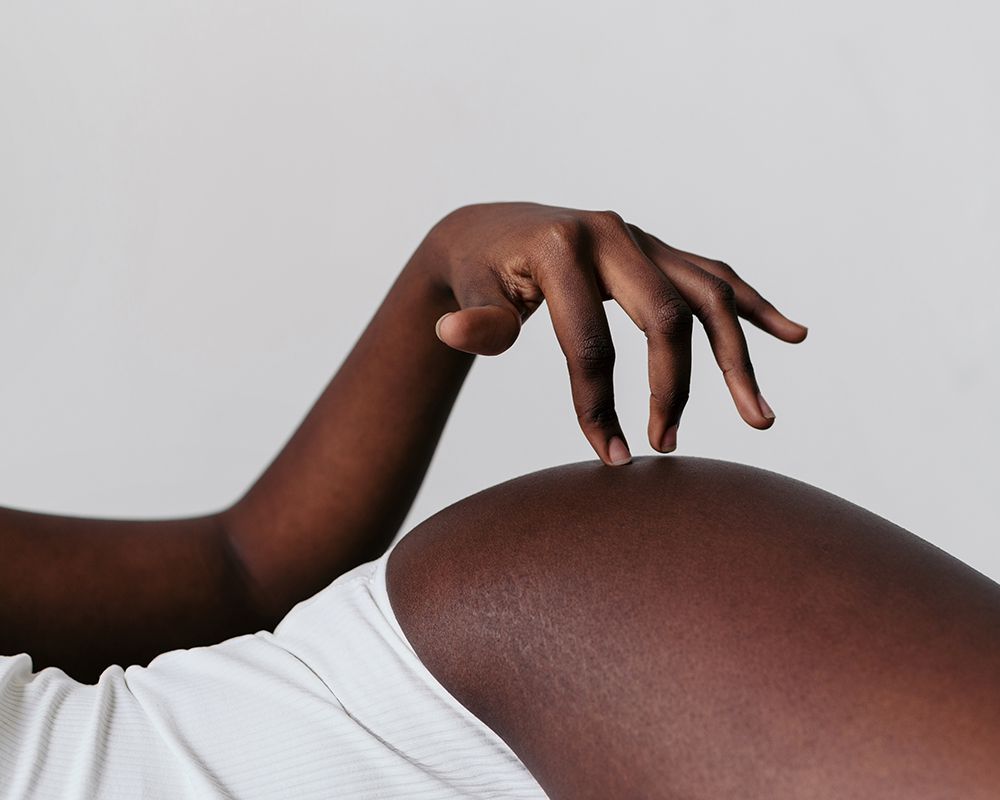Hip Piercings: Everything You Need to Know

Despite being almost always hidden, hip piercings are a great option if you want a piercing that stands out. During the day to day, hip piercings are hidden by clothing, meaning they have an inherently intimate vibe about them. But when they’re visible, these piercings make a major impact due to their edgy style. Although popularized during the 2000s’ boom of low-rise jeans, hip piercings are making a comeback as a statement-making, cool piercing applicable for any style.
Meet the Expert
- Courtney Morrison is a body piercer at Art Immortal Tattoo & Piercing in Tennessee.
- Luis Garcia is a Philadelphia-based professional piercer.
- Dr. Weston Waxweiler is a board-certified dermatologist with the Cleaver Medical Group.
Hip Piercings
Placement: Located on the front hip right beside the hip bone
Pricing: Around $50-$60
Pain level: 6/10, according to Morrison
Healing time: 6 months for a dermal piercing, 8-12 months for a surface piercing
Aftercare: Wash the piercing twice per day with a sterile saline solution until fully healed, and avoid anything that could irritate the fresh wound
What is a Hip Piercing?
In rather literal terms, a hip piercing is simply a piercing located on the hip area. There are two different kinds: a surface piercing and a dermal piercing. A surface hip piercing technically has two piercings sites, as it has an entry and exit point. These types of piercings are done by threading a needle under the skin and pushing a small metal bar through to keep the hole open. Then, it’s secured on its open end with a non-fixed ball (the other end of a barbell is a fixed one). Dermal piercings, on the other hand, consist of an anchor and a top. This type of hip piercing is done by puncturing the skin to create an empty space in which a small anchor is pushed into. It is then secured with the top, aka a non-fixed, flat end.
Which kind of hip piercing to go with really depends on your style and preference. A surface piercing creates the illusion of having two piercings in one, while a dermal piercing creates the illusion of a piece of jewelry sitting flat against the skin.
Pain and Healing Time
“It’s difficult to explain how much something will hurt from person to person,” says Courtney Morrison, a body piercer at Art Immortal Tattoo & Piercing in Tennessee. “I have had some clients tell me they didn’t feel a thing, and I’ve had others tell me it was pretty painful.”
Pain isn’t a universal feeling, so depending on your personal tolerance level, a hip piercing could be super painful or a walk in the park. Morrison says that if she had to rate the pain, she’d give it a 6 or 7 out of 10. But for Luis Garcia, a Philadelphia-based professional piercer, the pain is more of a 3 or 4 out of 10. If you’re nervous about the pain factor, consider just how much you want the piercing—if you want it badly, the pain will be worth it.
Like any body modification, hip piercings aren’t good to go as soon as you walk out of the shop. Instead, you have to care for your fresh piercings until they heal fully. Much like the pain level, the length of time may vary based on your care routines, potential irritation, your body’s immune system, and what kind of piercing you get.
“A surface bar piercing in the hip area will take 8-12 months to heal fully,” says Garcia. “A surface anchor will take around 6 months.”
Cost of a Hip Piercing
The price of a hip piercing can vary greatly depending on where in the world you are, how experienced your piercer is, and how many you’re getting at once. Expect to pay between $40 and $100 for the piercing, though they’re typically around $50-$60. Be sure to ask your piercer if jewelry is included in the price as well, as some shops may require an additional purchase instead.
Aftercare
Aftercare for hip piercings, both dermal and surface, is the same as it is for most other piercings: clean your piercing twice a day with a sterile saline solution until fully healed. Garcia notes it’s important to make sure to only use the sterile solution, as other products can irritate or directly infect the new piercings. “No soap, alcohol, peroxide, ointments, or creams should ever be used on any piercing,” he says.
During this period, you have to be hyper-vigilant about your piercing—both in terms of cleanliness and physicality. As well as making sure you’re washing the piercing twice a day, you have to make sure to shower after working out; avoid soaking, either in tubs, pools, or the ocean; and not let the piercing snag on anything from clothing to sheets.
“It is important while the piercing heals to keep it clean and free of germs,” says Dr. Weston Waxweiler, a board-certified dermatologist with the Cleaver Medical Group. “Leave your piercing alone unless you are cleaning it.”
Side Effects of Hip Piercings
- Rejection: “Hip piercings, like all surface piercings, are known for [rejection],” says Morrison. Rejection is when your body pushes a piercing out of your skin because it falsely perceives it as a threat. The wound heals up as the jewelry is pushed out as well, healing over. This process happens fairly slowly, so if you notice rejection, see a medical professional to have your piercing removed immediately.
- Infection: If you notice your piercing is draining yellow or white fluid, or if it is red and hot to the touch, you may have developed an infection. This can happen if aftercare isn’t followed properly or if the piercing is irritated during the healing process. “Infection can lead to serious complications including scarring, fever, chills, and even hospitalization,” says Waxweiler. “If you suspect your piercing is infected, please see your doctor immediately for a possible antibiotic prescription.”
- Scarring: If your piercing faces any major complications, like an infection, movement around the skin, or rejection, it may result in permanent scarring. To avoid this, be sure to find an experienced piercer from beginning, and take proper care of the piercing during the aftercare period.
How to Change Out a Hip Piercing
It’s totally possible to change out your hip piercing, but it’s crucial that you wait until they’re fully healed to even touch them—anywhere from 6 months to a year. If you attempt to switch out the jewelry during the healing process, you could experience issues as serious as an infection, or the piercing closing over. Even after the piercing is healed, changing it yourself could cause a bit of harm, so if you’re not confident, it’s best to go back to your piercer. This is especially true for dermal piercings, as it’s easier than you’d expect to accidentally dislodge the anchor.
“I suggest visiting a reputable piercer to have that done, as… these piercings can be easily irritated if the ends aren’t changed in the right way,” says Garcia.
If you do want to change out your jewelry and you have a dermal piercing, it is possible to do by yourself if you’re careful. Simply twist off the dermal cap and replace it with the new one. For surface piercings, Morrison says you can twist off the balls on either end and replace them, but you must leave the bar under the skin—you can’t replace that part.
What Types of Jewelry Are Used for a Hip Piercing?
- Curved Barbell: A curved barbell consists of a small, slightly curved bar with a ball on either end—one is fixed and one is removable. If you get a surface hip piercing, they use one of these. These are the same kind of barbells that other piercings, like snug piercings, use, so there are a number of style variations so you can be satisfied no matter your aesthetic.
- Dermal Anchor And Top: If you get a dermal hip piercing, the jewelry is a bit different. This piercing is made up of an anchor that is pushed into a small hole in the skin. After it’s in place, a top is screwed on to secure the anchor into the skin. While the anchor is not removable, the dermal tops come in a seemingly limitless amount of looks to match your style.
What Jewelry Material Is Used for a Hip Piercing?
When choosing your jewelry, be sure to consider any allergies or skin sensitivities. “Many of my patients are allergic to nickel and many of the metal piercings out there contain some sort of nickel,” says Waxweiler.
- Titanium: If you have an allergy to nickel, titanium is your best bet, as it contains none. It’s also lightweight and won’t tarnish, so you can be sure your jewelry will look good for as long as you want it to. “Consider going with titanium,” says Waxweiler. “We can try [others] later, but while the piercing initially heals, stick to something a little less risky.”
- Surgical steel: If you want something a bit more heavy-duty (though not heavy), surgical steel is a great option. It’s the most common type of jewelry metal and comes in a variety of shapes and colors, meaning you can customize your piercing to your liking.
- Gold: Gold is another great option for jewelry if you prefer the metal’s look over silver or a colored metal. Be sure that any gold jewelry is over 14 karats, though, as anything lower could harbor harmful bacteria.
How to Tell If Your Body Is Rejecting a Piercing









